Rwandan troops killed a soldier from the Democratic Republic of Congo (DRC) who crossed the border on Saturday, the latest escalation in a complex military and political crisis that threatens to destabilize Central Africa.
The Rwandan Defense Ministry said on Saturday the Congolese soldier crossed the border into the Rubavu district of Rwanda and was killed after he began firing on guard towers manned by the Rwanda Defense Force.
The DRC military described the errant soldier as a new recruit who got lost during a night patrol and crossed the border by accident.
Relations between Rwanda and the DRC are extremely tense because some Congolese politicians and citizens accuse Rwanda of supporting M23, a vicious rebel group in the eastern DRC that is slowly gaining ground against the Congolese military.
M23, more formally known as the March 23 Movement or Mouvement du 23 Mars in French-speaking Congo, is the latest iteration of an insurrection that dates back to the 1990s. Most M23 fighters belong to the Tutsi tribe, an ethnic group that extends into Rwanda. A large number of Rwandan Tutsis were slaughtered by the rival Hutu tribe in the Rwandan genocide of 1994, a conflict that spilled over into the Congo and radicalized many of its Tutsis.
“March 23” is a reference to a peace treaty signed on March 23, 2009, that sought to end the insurrection by turning it into a legitimate political party and incorporating its fighters into the DRC military.
The peace deal was a failure, as M23 refused to demobilize and there was little appetite among the rest of the Congolese public for granting amnesty or other concessions to the insurgents. The rebellion was back in business by 2016, under a name that mocked the March 23 agreement.
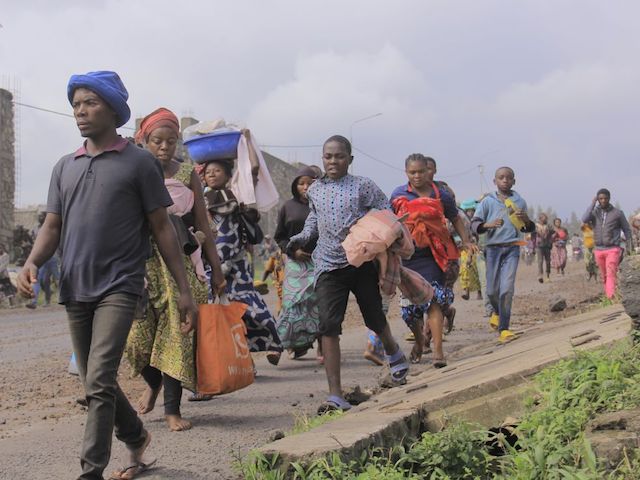
Citizens, fleeing the conflicts in the Kanyarushinya region, arrives in the city of Goma as the clashes between Congolese army and M23 rebels continues in Goma, Democratic Republic of the Congo on November 14, 2022. (Augustine Wamenya/Anadolu Agency via Getty Images)
M23 began attacking villages and seizing territory in 2021, adding to the chaos caused by Islamic State militants and an equally ugly radical group called CODECO, the “Cooperative for the Development of the Congo,” an alliance of militias from another tribe called the Lendu that shares M23’s penchant for horrifying civilian massacres.
There is little question that Rwanda played a major role in founding the M23 movement in the DRC. A bombshell United Nations report in 2013 said officials from the administration of Rwandan President Paul Kagame – an ethnic Tutsi who was the darling of international progressives in the 1990s but was later accused of war crimes – were heavily involved in recruiting and arming M23 fighters.
Kagame is still in power in Rwanda, having held the office of president since 2000. Journalists and opposition candidates have a nasty habit of dying during his re-election campaigns, but he still enjoys some international praise as a reformer and “benevolent dictator.” He is perpetually on the verge of maxing out the credit card of good faith granted to him by the international community for halting the Tutsi genocide. Kagame has overseen modifications to the Rwandan constitution that would allow him to remain in office until 2034.
In April 2022, another report prepared by the United Nations Security Council (UNSC) cited “solid evidence” that Rwanda is not only backing the M23 insurgency but sending troops into the DRC to fight alongside the rebels.
The UNSC report, which was confidential but seen by several international media organizations, said Rwandan troops began making incursions into Congolese territory in November 2021, serving as “troop reinforcements” for M23 operations “aimed at seizing strategic towns and areas.”
One prominent example was the M23 assault on a DRC army base in the town of Rumangabo in May, an attack that enjoyed so much Rwandan support that the U.N. report described it as a joint military operation.
“On repeated occasions, aerial imagery showed large columns of up to 500 armed men in the vicinity of the DRC, Rwandan and Ugandan borders, moving in a very organized manner,” the report said.
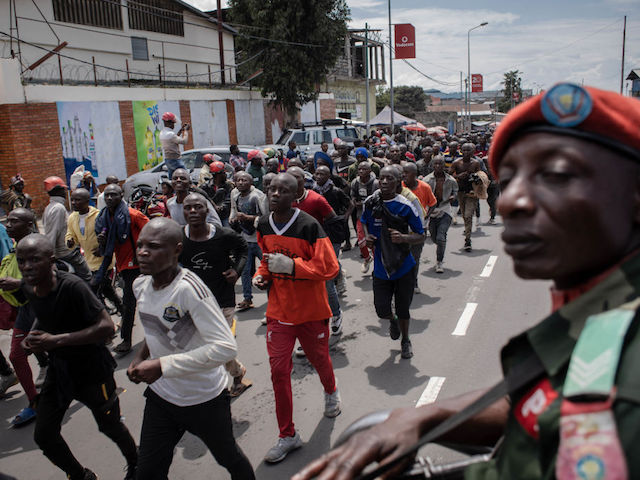
Hundreds of volunteers march to the airport to be directed to a training center after responding to Democratic Republic of Congo’s President Felix Tshisekedi’s call to join the army to go to the front lines to fight against the M23 rebellion (March 23 Movement) in Goma, Democratic Republic of Congo, on November 14, 2022. (GUERCHOM NDEBO/AFP via Getty Images)
UNSC experts said they had reviewed credible photographs of Rwandan soldiers in M23 camps, providing the fighters with Rwandan military uniforms and equipment.
According to the report, the Rwandans are particularly interested in using M23 as a proxy force against militia groups in the DRC that threaten Rwandan interests, including a Hutu militia known as the Democratic Forces for the Liberation of Rwanda (FDLR). The UNSC panel of experts said Congolese soldiers have fought alongside the FDLR.
Rwanda accuses the DRC of supporting this group in much the same way the DRC accuses Rwanda of supporting M23. Both the Rwandan and Congolese governments officially deny these allegations.
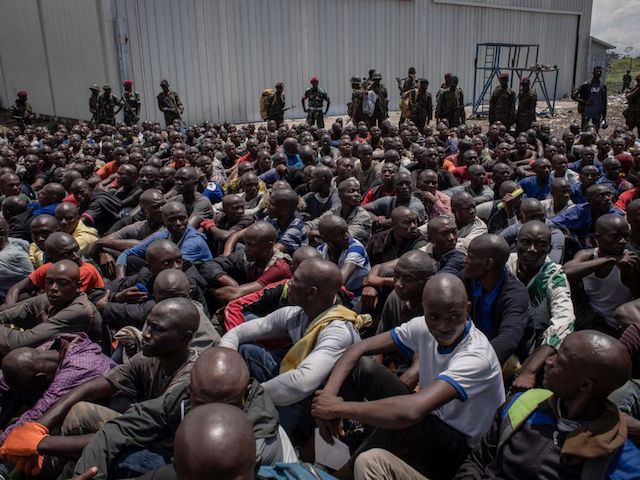
Hundreds of volunteers sit at Goma International Airport before boarding a plane that will take them to a training center after responding to Democratic Republic of Congo’s President Felix Tshisekedi’s call to join the army to go to the front lines to fight against the M23 rebellion (March 23 Movement) in Goma, Democratic Republic of Congo, on November 14, 2022. (GUERCHOM NDEBO/AFP via Getty Images)
Uganda is also in the mix, as its forces have been deployed into the DRC to fight an ISIS-linked terrorist group called the Allied Democratic Forces (ADF).
The ADF began as a fusion of Ugandan rebel groups but migrated to the Congo in 1995, remodeling itself as an Islamist movement and eventually swearing allegiance to the Islamic State in 2019.
The ADF recruits both Congolese and Ugandans, its agenda includes overthrowing the governments of both countries to create an Islamic “caliphate,” and it is regarded as a lethal security threat by both the DRC and Uganda. The ADF’s terror tactics have been a major impediment to fighting Ebola outbreaks in the Congo.
If things sound crowded between M23, CODECO, and the ADF, consider they are but the three largest of roughly 120 militias identified as active in the Congo in the 2022 UNSC report. Many of those militias are directly aligned with, or tacitly supported by, the governments of Rwanda, Uganda, or the DRC. Many of their leaders served as officers in one of those three national armies, bringing military tactics and organization to their insurgent activities.
Some observers view the current crisis as essentially a proxy war between Uganda and Rwanda for control of the Congo, which they jointly invaded in 1996 to install a government more agreeable to their interests.
Kagame is a veteran of the Ugandan military who came to power in Rwanda with Ugandan support in the coup that ended the 1994 genocide. In Uganda, he was an intelligence officer who helped Yoweri Museveni take power in a coup of his own in 1986. Like Kagame, Museveni is still in office decades later, although the two presidents-for-life have lately fallen out, accusing one another of supporting subversive forces that threaten their respective regimes.
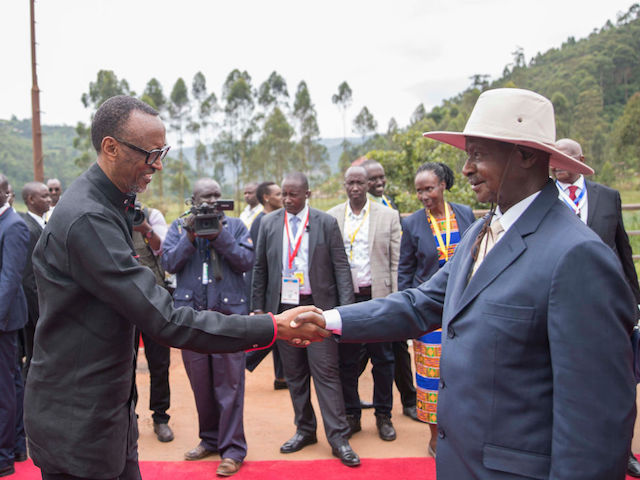
Rwandan President Paul Kagame (L) and Ugandan President Yoweri Museveni shake hands during a meeting at the Gatuna-Katuna border crossing between Rwanda and Uganda, on Feb. 21, 2020. (Xinhua News Agency via Getty Images)
The proxy war in the DRC is even more chaotic and bloody than even all of that history would suggest because the militia groups are also nursing old tribal hatred and political grudges, so they have a habit of turning on each other and murdering civilians they view as loyal to their enemies. M23 is also exceptionally vicious about murdering any civilians it accuses of “treason” for assisting the DRC military.
M23 has been on a roll in the Congo since May, scoring a 300-percent increase in the territory it controls and displacing thousands of civilians. It has surpassed the ADF as the worst of many security threats faced by the DRC.
In the span of about six months, beginning with its surprising resurgence in November 2021, M23 managed to seize territory along both the Ugandan and Rwandan borders and overrun the Rumangabo military base (allegedly with a good deal of assistance from Rwandan forces).
DRC and Rwandan artillery units have exchanged fire as M23 advanced. Each side claimed the other attacked across the border first. The DRC military accused Rwandan of using rocket artillery to support M23 advances and said Rwandan strikes have killed Congolese civilians.
In October of this year, after M23 seized control of two major towns in the eastern Congo and fired on U.N. peacekeepers, the DRC expelled Rwanda’s ambassador.
After one year of fighting, M23 now threatens the city of Goma, capital of the DRC’s North Kivu province. A pivotal battle between government forces and the insurgents for control of Goma is looming, and tens of thousands of Congolese civilians have already fled the battlefield. The DRC is using aerial bombardments and heavy artillery strikes against M23 positions, raising fears of civilian casualties.
Other regional powers are increasingly concerned the Congo chaos could spread across their borders, or spark a war between the DRC and its neighbors. If the M23 crisis truly began as part of a proxy fight between Kagame in Rwanda and Museveni in Uganda, they both might be having second thoughts as the situation spirals out of control.
Uganda, which formally concluded its joint operation with the DRC against ADF terrorists this year, announced on Tuesday it will deploy a thousand soldiers into the eastern DRC by the end of November. About 900 Kenyan troops have already been deployed to the DRC to assist the government.
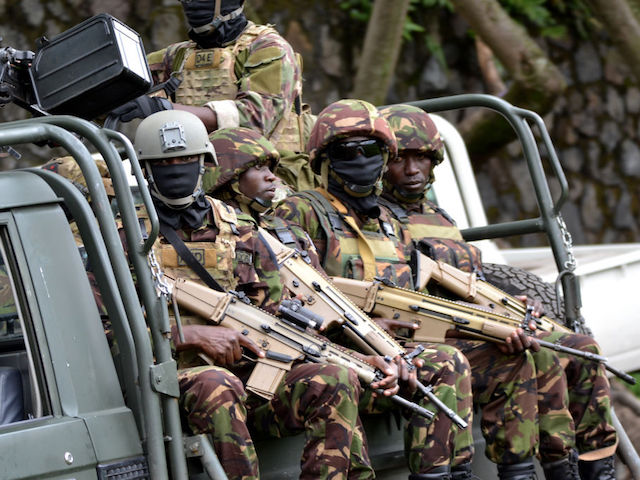
Military troops are seen after a military plane, carrying Military troops sent by Kenya to the eastern Democratic Republic of the Congo (KDC) to prevent ongoing clashes between Congolese army and M23 rebels, arrives in Goma, Democratic Republic of the Congo on November 16, 2022. The Kenyan army sent hundreds of soldiers to the area today, after the dispatch of 900 soldiers on November 12. (Photo by Augustin Wamenya/Anadolu Agency via Getty Images)
A newly-formed cooperative called the East African Community (EAC), which counts the DRC, Uganda, Rwanda, and Kenya as members, called on M23 to disarm – and warned that an international force could be sent against them if they keep fighting.
“Those who fail or refuse to voluntarily disarm, then we’ll go for them,” warned EAC chief Jeff Nyagah, who is a general in the Kenyan army. Nyagah explicitly pledged to use EAC forces to protect Goma from the insurgency.
The EAC also offered to broker a “peace dialogue” in the Kenyan capital of Nairobi on Monday, chaired by former Kenyan president Uhuru Kenyatta, but the meeting was postponed at the last minute. On Tuesday, the administration of DRC President Felix Tshisekedi said it would not meet with M23 representatives until the group withdraws from the towns it has captured.
M23 has displayed little interest in peace talks, possibly because the group thinks it can achieve its political objectives by capturing Goma and then making Tsisekedi pay a heavy price in concessions to get it back. Kenyatta, the EAC’s chief mediator in the conflict, on Tuesday asked Kagame to help him convince M23 to accept a ceasefire – a move immediately interpreted by the DRC as an admission of Kagame’s culpability in launching and supporting the M23 insurgency.
“It is encouraging to see Paul Kagame recognize that he can influence the M23. We will see what happens on the ground,” sneered a Tshisekedi spokesman.
On Wednesday, the DRC and Rwanda held de-escalation talks in Angola, mediated by Angolan President Joao Lourenco. Tshisekedi attended the talks, but Kagame did not, sending his foreign minister Vincent Biruta instead.
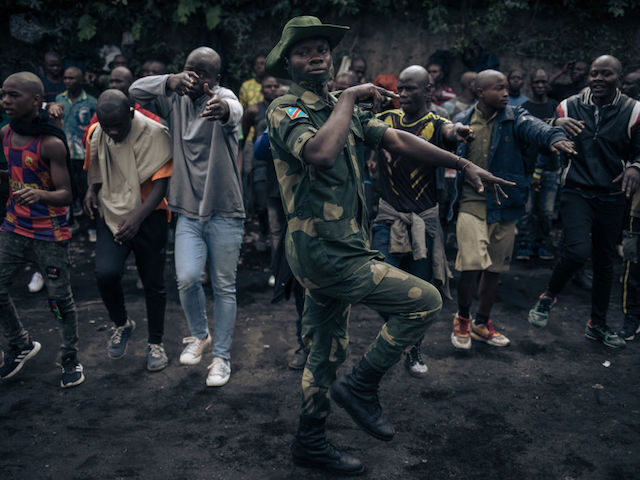
COMMENTS
Please let us know if you're having issues with commenting.